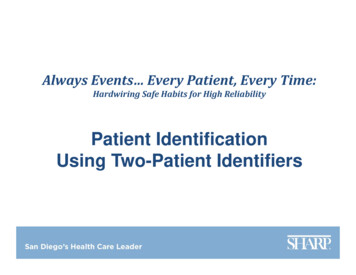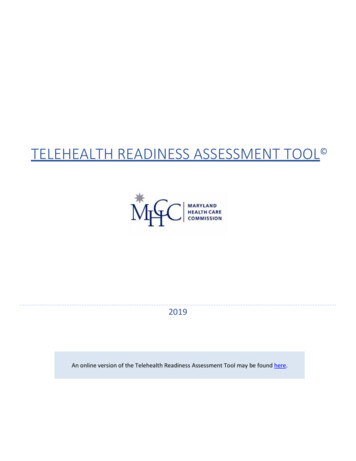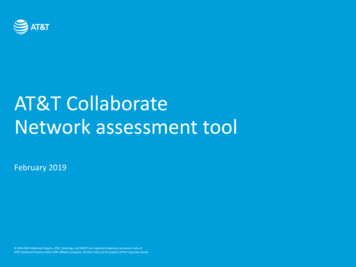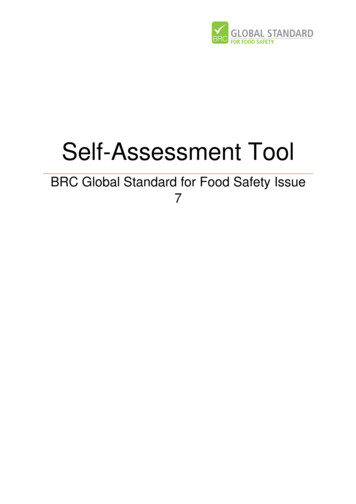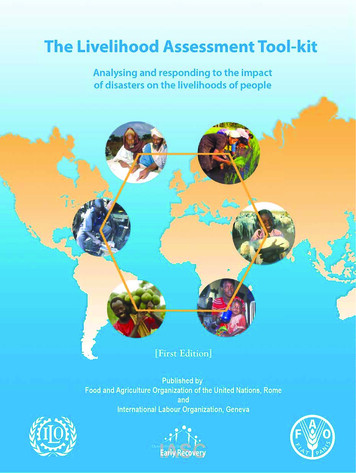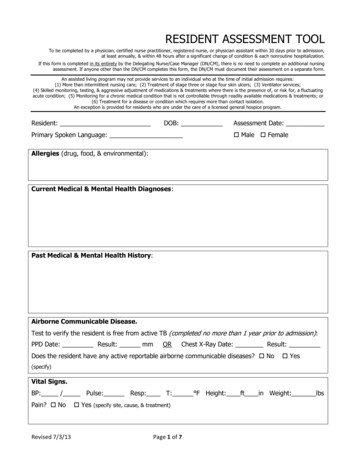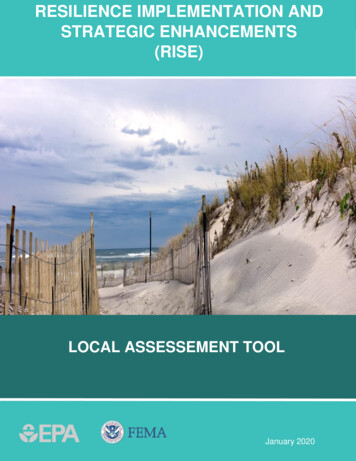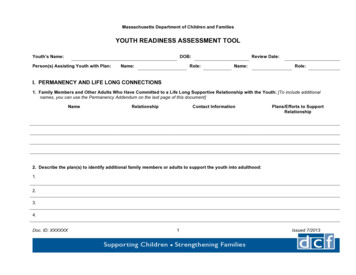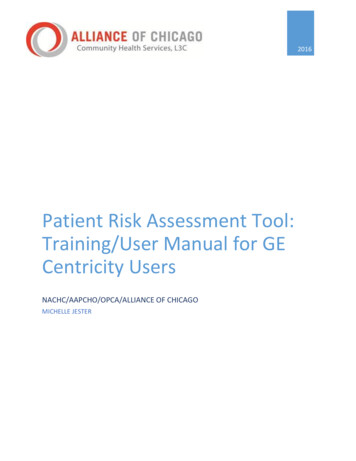
Transcription
2016Patient Risk Assessment Tool:Training/User Manual for GECentricity UsersNACHC/AAPCHO/OPCA/ALLIANCE OF CHICAGOMICHELLE JESTER
Table of ContentsOverview of the PRAPARE Project2Standard Data Collection Workflow5PRAPARE Tool Form – Screenshot7PRAPARE Form FAQ9Change Management14Social Determinants of Health – Sensitivity Training16Best Practices & Lessons Learned171
Overview of the PRAPARE Project: Implementing a NationalStandardized Patient Risk Assessment in Electronic Health RecordSystems[Taken from NACHC’s Implementing a National Standardized Patient Risk Assessment in Electronic Health Record SystemsProject Charter Document]Health Centers and the Social Determinants of Health: Implementing a National Standardized PatientRisk Assessment Protocol in Electronic Health Record Systems (EHRs)Background:In September 2013, the National Association of Community Health Centers (NACHC), the Association ofAsian Pacific Community Health Organizations (AAPCHO), the Oregon Primary Care Association (OPCA),and the Institute for Alternative Futures (IAF) launched a project funded by the Kresge Foundation,Kaiser Community Benefit, and Blue Shield of California Foundation to create, implement, and promotea national standardized patient risk assessment protocol that goes beyond medical acuity to identify riskrelated to the “social determinants of health” (SDH). The goal of this project is to develop and pilot aconsensus-driven national standardized patient risk assessment protocol in partnership with healthcenters and their networks to 1) help health centers better understand and manage their patientpopulations, 2) support development of payment methodologies that sustains SDH-relatedinterventions.Millions of people in the U.S. live in circumstances or with a history that significantly their health. Theseinclude social, environmental, and economic factors that influence an individual’s health. SDH act asbarriers to good health outcomes and increase health care costs through preventable health careutilization. The national network of Community, Migrant, Homeless, and Public Housing Health Centersendeavors to overcome the SDH challenges experienced by their 23 million patients in their clinicalpractice and community activities. Fully addressing SDH, however, requires capturing data to documentand better understand the specific SDH-related risks of their patients. Standardized data on non-clinicalpatient risk (e.g. education, employment, homeless status) will help health centers fully assess patientand community needs, identify high priorities, develop sustainable, coordinated, and culturally andlinguistically appropriate interventions, and ultimately impact SDH risks, outcomes, costs, and patientexperiences. It will also help inform new payment systems as current systems do not adequatelyincentivize the prevention or management of SDH nor do they cultivate community partnershipsnecessary for approaching health holistically.This tool was designed specifically to aid health centers in gathering data that informs and addressesindividual patient care and population health management, while capturing what makes health centerpopulations unique.2
PRAPARE will be used to meet these goals by:1. Patient and Family: Empowering patients- Asking patient-centered questions about risk and allowing patients to prioritize needs- Opening up the conversation between patients and their care team about non-clinical risks andunmet needs2. Care Team Members: Improving point of service care management- Giving the care team information on patient risk/needs prior to the visit to inform counselingand referrals during visit- Giving the care team a more complete context of the patient’s medical conditions, risks, andutilization patterns3. Health Center: Improving the health of the patient population- Gathering data that can be aggregated to inform the allocation of resources and services andto identify disparities between patient population segments4. Community Policies: Informing policies- Gathering data that can be aggregated to inform/promote legislation and policies (e.g.,continued federal 330 funding, direct state grants, policies around specific social determinants,like housing)5. Local Health System: Encouraging and strengthening partnerships across organizations- Encouraging local partnerships for bi-directional referral services- Creating an opportunity for meaningful data sharing (eg. ACO model of sharing utilization data,sharing aggregate data for comparison across healthcare organizations)3
6. State and National Policies: Gathering evidence for advocacy and payment reform- Gathering robust quality data to validate a risk adjustment algorithm for payment negotiationWHY Should Your Organization Help Pilot PRAPARE?This tool was developed to help further the mission of your organization and we need your help! It isbased on research and stakeholder input, but needs to be tested by staff in the field to make it as strongas possible. This is your chance to test and provide feedback on a tool that will ultimately be nationallydisseminated.Piloting PRAPARE is an opportunity for innovation and problem solving in multiple areas of clinic workflow.Data collection process: Currently, most patient data is gathered in the waiting room or during the exam. There are other interaction times which are an underutilized resource for assessmentadministration. Prior to patient arrival at clinic (reminder phone calls, online patient portals) Prior to patient exam (during measurement of vital signs, during wait in exam room) After the patient leaves the exam room (in-house referrals for further assessment,during check-out)4
Standard Data Collection WorkflowDepending on your health center’s internal workflows and operations, the data collection workflow willbe tailored towards your health center and what works best in your organization’s operationalworkflow. Below is a standard data collection workflow where the PRAPARE questions are embeddedwithin a normal office visit. The Alliance of Chicago is recommending that the data collection is donewithin two workflows:1. Standard Office Visit2. Care Coordination Visit5
Sample WorkflowsSample #11. Nursing team will identify patients needing annual administration of SDH survey when preppingcharts and by viewing protocol tab.2. When patient due for SDH survey is being roomed by the nurse, tool will be administered eitheron paper and later inputted into EMR, or inputted directly into EMR by nurse.3. If SDH is identified, nurse will either use SDH spreadsheet to provide patient with resourceinformation or notify case manager or social worker to assist patient.4. Provider should also be notified of SDH identified might impact care given that visit (i.e. unableto afford medications)Sample #21) Present to the patient explaining how we are involved with PRAPARE:a. Introduce yourself, and ask the patient if they would mind answering some questions tohelp the clinic better understand the needs of our patients.b. “PRAPARE is a nationwide pilot program People’s Clinic has been chosen to participatein to help ensure the diverse population we manage get the best possible care providedto them. This program helps PCHC determine what resources are needed to help ourpatients.”c. After rooming the patient, hold the office visit to the provider.d. Open a separate document- choose PRAPARE as the encounter type.e. Leave your name in the provider box- click OK. (Do not associate it with the office visit)f. Click Add PRAPARE to Note (If something is needed to be left out of the charting, canunclick the specific ‘Add to note’ box for that section)g. Ask the questions and answer accordingly for each tab:Sociodemographic/Socioeconomic, Money and Resources, and Psychosocial Assets. Ifthe patient refuses to answer questions, choose the appropriate answer reflecting this.h. Before asking questions under the Psychosocial Assets tab- Additional Optional Domainssection, remind the patient “these questions are just for our data. They will not be usedfor anyone else’s viewing.”i. After the questions are done, thank the patient and hold the document to yoursupervisor’s desktop.j. Resources are available onsite to address immediate issues.k. There is a referral protocol in place for other non-emergent issues needing referrals.6
PRAPARE Tool Form –Sample ScreenshotThe Alliance of Chicago Community Health Services created the PRAPARE tool within a Centricity Formfor Health Centers to administer within the Electronic Health Record. Below is an example screenshot ofthe tool and the format the tool is in for health centers to utilize.Sample Form ScreenshotsSociodemographic/Socioeconomic TabMoney & Resources Tab7
Psychosocial Assets Tab8
PRAPARE Form FAQSETUPHealth Centers should have the designated/responsible team member to install the Alliance Content.Please work with your EMR team to determine the best time to load this content into your trainingand/or live databases for review.Files Included:1. Zip file with the PRAPARE form and text component.a. Current Version: PRAPARE v1.06 20160926.zipForm Last Revised: 9/6/20162. Zip file with the latest observation terms.a. This kit must be installed in order for the form to work correctly.b. Current Version: Alliance 2016 August ObsTerms.zipLast Updated: 8/29/20169
The PRAPARE form defaults to having display fields for information captured in the CHC Add-On module.However if you want to enable these fields for data entry in the EHR, a simple change must be made.1.2.3.4.Go to Administration Chart Chart Documents Text Components.Navigate to the Alliance folder Custom Alliance PRAPAREClick customizeChange the “yes” to “no” {gCHC VISUALUTIONS "yes" ""}{gCHC VISUALUTIONS "no" ""}10
FORM USE1. Sociodemographic/Socioeconomica. Ethnicity, Race and Preferred Language: Pulls from standard registration fields.b. Veteran Status and Migrant Status: The goal is that this information will eventually pullover from the CHC tab. (NOTE: These fields can be enabled using setup instructions.)c. Patient Address: Pulls from standard registration field.d. Family Size and Monthly Family Income: The goal is that this information will eventuallypull over from the CHC tab. (NOTE: These fields can be enabled using setupinstructions.)e. Housing Situation: Should be captured on the form.This button when clicked will removethe ENTIRELY. All “Add to Note”buttons will automatically uncheck.? Button throughout theform gives usersadditional information ordefinitions to clarify thequestion being asked.11
2. Money and Resourcesa. Complete question as needed.Previous buttons will pull in theinformation previously capturedfor this patient.Selecting ‘No’ to Insecurityquestion, automatically fills in‘No’ to detailed responses.ICD-10 codes will populate to addto the problem list based on howthe patient answersPrevious values will display onthe left hand side in light grey.12
3. Social and Emotional Healtha. Complete question as needed.4. Additional Optional Domainsa. Complete the optional domains as specified by your Health Center.‘Afraid of partner?’: A responseof ‘Yes’ will show button to jumpto ‘HITS’‘How Stressed Are You?’: Aresponse other than ‘Not at all’will show button to jump to ‘PtStress Questionnaire’13
Change ManagementChange is a Process. We acknowledge that it will take time for staff to adjust and incorporate thetool within the current workflows set at the health center.PresentStatePAINTransitionStateThe Cycle of Change3 Strategies for Managing Resistance:REWARDSLOGISTICALHASSLESPUNISHMENT Expect it; don’t be surprised when it occurs. Recognize it for what it is – people are expressing their discomfort; it is not people being “bad”. Talk about it, describe it objectively without judgment or blame, at Team meetings.14
Develop strategies to deal with it:– Get more information about why people are uncomfortable.– Solicit their suggestions for what can be done to make them more comfortable.Roles in the Change Process: Sponsor - Individual or group who has the organizational power to legitimize the Change.Change Agent - individual or group responsible for implementing the changeTarget - individual or group being impacted by the changeAdvocate - individual or group who wants the change to occur and does not have the organizationalpower to legitimize it.Roles in the Implementation / Change Management Process for PRAPARE:-For this implementation to successfully roll out, it is important to determine the roles in thechange process and who will be in the front line at the participating health centers.o Sponsors: The Health Centers’ executive and senior leadership will be essential inlegitimizing the change, understanding the resources required to accomplish thechange, and committing to provide the resources needed to successfully roll out thePRAPARE tool. The sponsors of the health centers will have the ability and willingness tosustain support throughout the duration of the implementation.o Change Agents: The change agents would include the Health Centers/ PRAPAREimplementation team that the organization designates to lead the project. This team orgroup of core individuals will have the knowledge to empower other staff during thechange process, the willingness to solicit and provide ongoing feedback, skills atassessing the level of commitment from the key players and bolstering faltering support,and skills of recognizing and managing resistance.o Target: Understanding the Health Centers’ patients/population of focus is important tothe change process. The health centers will discern from the cognitive testing and frompersonal experience how to best administer the tool to the patients so that they are notresistant and they understand the questions being asked.o Advocate: Network level staff, other health center staff who are interested in SDH, etcwill help advocate for this change to occur. Advocated should do what they can tosupport health centers to successfully implement the PRAPARE tool (providingresources, training material, data, clinical content, monthly touch base meetings, etc.)Summary: PRAPARE Implementation is a CHANGE ProcessThis Process of Change will need to be “Managed”Roles in the change process should be clearly definedResistance is to be expected and can be managed[Please reference the Change Management PowerPoint Presentation for additional information onChange Management within your organization]15
Social Determinants of Health - Sensitivity TrainingSensitivity training will be conducted at the health center level with internal training materials andresources. The health centers will utilize their standard process of training staff on sensitivity andcultural competency.16
Best Practices & Lessons Learned The need to have demographic information entered in from registration: This will allow theinformation to pull over into the PRAPARE form in the EHR side and can refrain from duplicateadministration within the office visitEnsure staff are only capturing the data once when needed (ie. Every single encounter vs. annually)Ensure staff capture data in the appropriate part of the visit: Please be sure to follow your practicespecific workflow to ensure there is a smooth flow in the data collection processWhen there are changes to the form, obs terms will need to be submitted to GE in advance to meetnecessary deadlines-Key Findings:o UDS discrepancy with tracking Native Hawaiian and Pacific Islander status in CPS Interim Workflow: The only way for the health centers to capture thisinformation separately is to add the two as separate sub-races (Native Hawaiianand Pacific Islander) and then train health center staff as the old categorycannot be removed and there are patients already assigned to these categories.For reporting purposes, we can run a query to see if the sub-races are beingpulled in. This report will have to be built, generated, and run for each healthcentero Issues identified in the GE content Migrant Worker, Veteran Status, Income, & Family Size Status fields arecaptured on the Practice Management side of the application in the VisualutionsCHC Registration Tab but DO NOT populate on the PRAPARE form. In order forthe information to populate, health centers/HCCNs will need to work with thethird party vendor, Visualutions to install the scripts into the database for thefields in CHC Registration to populate as observation terms on the EMR side atan additional cost. Workaround: Unless the HC has implemented this script, the PRAPAREform provided will allow the Health Center to capture these four fieldsdirectly in the PRAPARE form by selecting from the drop downs or freetexting the response from the patient. It may require doubledocumentation if this information is already captured on the PracticeManagement side.o If Health Centers implement the Visualutions script, the Alliancecan provide the version of the PRAPARE form that allows for thefour fields in Practice Management to directly populate in thePRAPARE form on the EMR side of the application.-Lessons Learned/Best Practices To Develop Readiness:17
ooooEducate staff and leadership of the value of PRAPARE Educate everyone in the organization at a high level. Educate key players at a detailed level Get the right people on the bus!Be prepared to address concerns and questions from staff and administration We have too much going on right now to add another project We already screen for and address social determinants of health Once we identify a social determinant of health, are we accountable to providehelp to overcome the determinant? Who is going to be responsible for addressing the need?Catalog current countermeasure/resources available, both in-house and in thecommunity, for each social determinants of health surveyed on the tool Identify resources that need to be developed or improved. Identify community partnerships that need to be initiated or strengthened.Use “5 Rights” and PDSA cycle to develop workflow for administering and responding toPRAPARE tool.18
Aug 29, 2016 · on paper and later inputted into EMR, or inputted directly into EMR by nurse. 3. If SDH is identified, nurse will either use SDH spreadsheet to provide patient with resource information or notify case manager or social worker to assist patient. 4. Provider should also be notified of SDH identified might impact care given that visit (i.e. unableFile Size: 953KB


